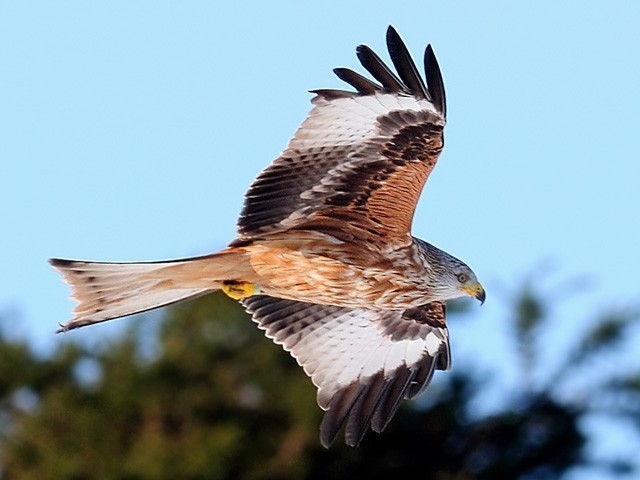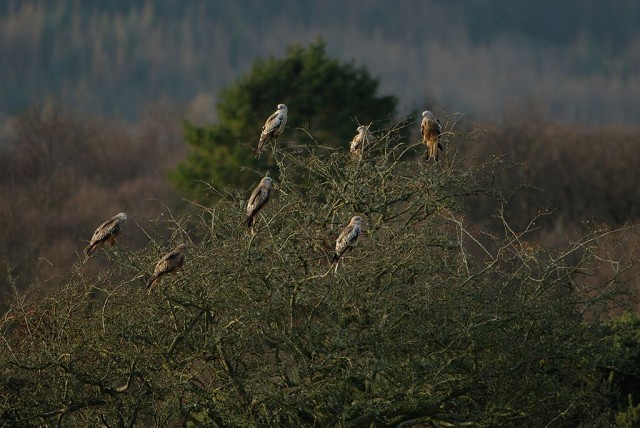Red Kites restored across Scotland
The last missing jigsaw piece of Scotland's 20-year Red Kite reintroduction effort is about to be put in place, with 36 birds due to be released on the outskirts of Aberdeen. This year is the third and final year of the Aberdeen Red Kite project, following other projects to bring the sociable bird of prey back to the Black Isle, Dumfries and Galloway and central Scotland. Local MSP and Convener of Holyrood's Rural affairs and environment committee Maureen Watt will release the first seven of these birds today [Thursday 16th July 2009].

Red Kite, Dunecht, Aberdeenshire (Photo:
Alan Sinclair)
The graceful Red Kite, with its distinctive forked tail, was once a common sight in towns and cities across the UK, and was considered useful in medieval times for its role as a scavenger, helping to keep streets clean. However, it later came to be considered as a pest and was hunted to near extinction in Victorian times, and by 1989 just a few pairs remained in North Wales.
The first Scottish reintroduction began on the Black Isle, north of Inverness, alongside another in the Chilterns, in the south of England. Further Scottish phases in Dumfries and Galloway and central Scotland, near Doune, saw the species build to around 90 pairs by 2006, but it was decided that the large gap in Aberdeenshire would need to be filled to give the species enough stongholds around the country to be self sustaining.
SNP North East MSP Maureen Watt said: "I am delighted to have been asked to take part in the RSPB's fantastic efforts to bring Red Kites back to the North East by releasing a new group of these magnificent birds of prey into the wild. Red Kites were once a common and welcome sight in this part of Scotland until human persecution caused them to disappear in the 19th century. It is wonderful that they are being restored to this part of Scotland and the hatching of several chicks earlier in the year is a sign for optimism for the future of the Red Kites."
Jenny Lennon, Aberdeen Red Kite project officer with RSPB Scotland, said: "We have 36 birds to release this year which means that, over three years of the project, 101 Red Kites will have taken to the skies of Aberdeenshire. These amazing birds are a pleasure to work with, and I still get a buzz every time I see them soaring overhead. Five pairs of birds that we released two years ago have already nested this year, so it looks like we're well on the way to a healthy population. Who knows, maybe soon Red Kites will once again be seen directly over Aberdeen itself."

Red Kite, Laurieston, Dumfries & Galloway (Photo:
Ged Connelly)
The birds not only play an important part in the countryside (they are excellent scavengers, cleaning up road kill, etc.) but have made a positive contribution to tourism in Scotland too, with feeding stations and viewing opportunities at Argaty Red Kites in Doune, and the Galloway Red Kite Trail.
History of the Red Kite reintroduction in Scotland
- 1989 6 imported Red Kites released on the Black Isle by RSPB Scotland and SNH.
- 1989-93 93 imported Red Kites released on the Black Isle over a five-year period.
- 1992 The first wild-bred Scottish chick in over a century is fledged.
- 1995 A pair of Scottish birds rear the first second-generation Scottish chick.
- 1996 19 imported Red Kites are released in central Scotland to help establish a second population centre.
- 1996-2001 103 Red Kites released in central Scotland.
- 1998 Central Scotland sees its first wild-bred chicks born in over 120 years.
- 2001 13 imported Red Kites, seized from wildlife criminals by German police, released in central Scotland and Dumfries and Galloway.
- 2002 24 Red Kites released in Dumfries and Galloway.
- 2003 The first wild-bred Dumfries and Galloway chick in more than a century is hatched. 33 Red Kites released in Dumfries and Galloway.
- 2004 10 Red Kites released near Loch Ken. 114 young fledged this year.
- 2008 Scottish population reaches a new high of 122 breeding pairs.
- 2006-2009 101 birds released in Aberdeenshire.

